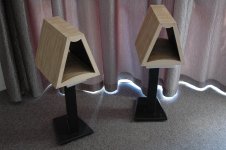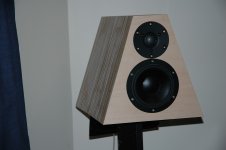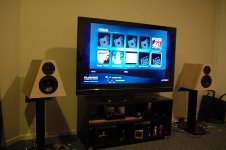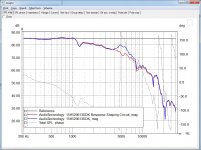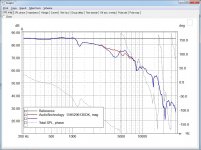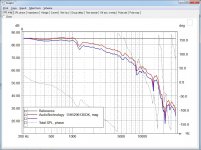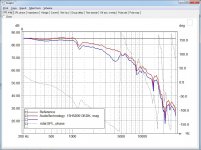After a long break =)
Here are the pics of the speaker....sadly unpainted...
Final volume for box : 10L
Tuning Frequency : 45Hz
Amp : Rod Elliot P3A (100W SS, with bias set so it runs in class A for first 0.4W)
Preamp (none)
Source : AC Ryan media player (adjustable volume)
Room : Very small (2.5m by 4m)
The crossover is very simple : 2nd order electrical (6.8uF and 0.4mH) for the tweeter with 4dB L-Pad.
The woofer has a single 1.5mH inductor to perform BSC as well as filter frequencies above 1000Hz. Will post a diagram soon.
Listening impressions : This is my best speaker build so far. I have built numerous Scanspeak designs and while the 18W8531 is superior in the lower bass, the AT 15H is simply better in the midrange and provides a superb midbass. In my small room, the bass goes to 45Hz cleanly, 35Hz is audible and response drops like a stone below 30Hz. I don't have any measurements done and all crossover parts were tuned by ear. I tried a second order crossover for the woofer, including BSC, but the sound was closed and thin. The single 1.5mH choke added a whole realm of openness and coherence to the sound. Almost like listening to an extended bandwidth driver. (fullrange speaker). The most astonishing trait of the speakers is its' lack of character. There is no midbass bloat, no brightening of cymbal crashes and absolutely no "metallic" or "plastic" sound signature left behind. The Scanspeak paper drivers have a distinct warm and laid-back sound, the 21W kevlar version has a slight nasal quality in the midrange. Even a Seas midwoofer filtered at 24dB/octave produces the breakup artifacts that propagate through the midrange and sounds slightly metallic. Thus, every mid-woofer that I've tried has a distinct character of its own, but these AT drivers leave none of that behind. Extremely neutral.
The inner walls of the box are lined with bitumen sheets and stuffed with Acousta Stuf.
The stacked panels help tremendously in reducing panel resonance, although there is a slight resonance at 500Hz from the box, and at 4000Hz (due to midwoofer breakup insufficiently damped). I will perhaps install a notch filter centered at 4Khz. However, these 2 resonance modes are very difficult to detect and after listening to 10 different albums, I noticed them on a couple of tracks. The killer test track I use for detecting resonances in speakers is Geoffrey Gurrumul Yunupingu, track called Wiyathul. 95% of speakers I auditioned have resonated the moment he hums. Another amazing thing this speaker does is it's ability to play all genres of music. I believe this is due to the low intermodulation distortion of the midwoofer as it is capable of resolving fine detail while kick drums are played simultaneously at fairly high levels. This is noted on Akon's track " I wanna f*** you". His voice remains crystal clear while the deep bass pounds the room. At this point the midwoofers are moving about 7mm, slightly over their x-max of 5mm. I have been very reluctant to push the drivers to the limits.
Overall a very balanced, full sounding bookshelf that images extremely well and throws a wide soundstage. Image depth is limited as my room is very small and the speakers are 1 feet from the back wall (the TV doesn't help at all).
What next? Maybe a 3 way with the same drivers and a 12'' sandwich cone AT woofer? Yeah right! I'll need a bigger room!
DIY forever!
Here are the pics of the speaker....sadly unpainted...
Final volume for box : 10L
Tuning Frequency : 45Hz
Amp : Rod Elliot P3A (100W SS, with bias set so it runs in class A for first 0.4W)
Preamp (none)
Source : AC Ryan media player (adjustable volume)
Room : Very small (2.5m by 4m)
The crossover is very simple : 2nd order electrical (6.8uF and 0.4mH) for the tweeter with 4dB L-Pad.
The woofer has a single 1.5mH inductor to perform BSC as well as filter frequencies above 1000Hz. Will post a diagram soon.
Listening impressions : This is my best speaker build so far. I have built numerous Scanspeak designs and while the 18W8531 is superior in the lower bass, the AT 15H is simply better in the midrange and provides a superb midbass. In my small room, the bass goes to 45Hz cleanly, 35Hz is audible and response drops like a stone below 30Hz. I don't have any measurements done and all crossover parts were tuned by ear. I tried a second order crossover for the woofer, including BSC, but the sound was closed and thin. The single 1.5mH choke added a whole realm of openness and coherence to the sound. Almost like listening to an extended bandwidth driver. (fullrange speaker). The most astonishing trait of the speakers is its' lack of character. There is no midbass bloat, no brightening of cymbal crashes and absolutely no "metallic" or "plastic" sound signature left behind. The Scanspeak paper drivers have a distinct warm and laid-back sound, the 21W kevlar version has a slight nasal quality in the midrange. Even a Seas midwoofer filtered at 24dB/octave produces the breakup artifacts that propagate through the midrange and sounds slightly metallic. Thus, every mid-woofer that I've tried has a distinct character of its own, but these AT drivers leave none of that behind. Extremely neutral.
The inner walls of the box are lined with bitumen sheets and stuffed with Acousta Stuf.
The stacked panels help tremendously in reducing panel resonance, although there is a slight resonance at 500Hz from the box, and at 4000Hz (due to midwoofer breakup insufficiently damped). I will perhaps install a notch filter centered at 4Khz. However, these 2 resonance modes are very difficult to detect and after listening to 10 different albums, I noticed them on a couple of tracks. The killer test track I use for detecting resonances in speakers is Geoffrey Gurrumul Yunupingu, track called Wiyathul. 95% of speakers I auditioned have resonated the moment he hums. Another amazing thing this speaker does is it's ability to play all genres of music. I believe this is due to the low intermodulation distortion of the midwoofer as it is capable of resolving fine detail while kick drums are played simultaneously at fairly high levels. This is noted on Akon's track " I wanna f*** you". His voice remains crystal clear while the deep bass pounds the room. At this point the midwoofers are moving about 7mm, slightly over their x-max of 5mm. I have been very reluctant to push the drivers to the limits.
Overall a very balanced, full sounding bookshelf that images extremely well and throws a wide soundstage. Image depth is limited as my room is very small and the speakers are 1 feet from the back wall (the TV doesn't help at all).
What next? Maybe a 3 way with the same drivers and a 12'' sandwich cone AT woofer? Yeah right! I'll need a bigger room!
DIY forever!
Attachments
Hi chlorofille,
Nice build and with an unusual enclosure shape!
You have chosen two very capable and nice sounding drivers.
Yes, I agree the AT 15H has one of the mid-range reproductions I’ve heard.
However, I do think that a 1.5mH coil in series gives a perfect BSC, but isn’t enough to tame the frequency response. I would recommend a response shaping filter in order to obtain a perfect frequency roll-off.
If you look at the attached picture you see the effect of the response shaping filter. Together with a 1.5mH coil it gives a smooth roll-off.
Picture1:
Blue = Without response shaping filter, 15deg off-axis measurement.
Red = With response shaping filter, 15deg off-axis measurement.
Regards
/Göran
Nice build and with an unusual enclosure shape!
You have chosen two very capable and nice sounding drivers.
Listening impressions : This is my best speaker build so far. I have built numerous Scanspeak designs and while the 18W8531 is superior in the lower bass, the AT 15H is simply better in the midrange and provides a superb midbass
DIY forever!
Yes, I agree the AT 15H has one of the mid-range reproductions I’ve heard.
However, I do think that a 1.5mH coil in series gives a perfect BSC, but isn’t enough to tame the frequency response. I would recommend a response shaping filter in order to obtain a perfect frequency roll-off.
If you look at the attached picture you see the effect of the response shaping filter. Together with a 1.5mH coil it gives a smooth roll-off.
Picture1:
Blue = Without response shaping filter, 15deg off-axis measurement.
Red = With response shaping filter, 15deg off-axis measurement.
Regards
/Göran
Attachments
Nice build chlorofille, any plans for some bass units for them to sit on in the future?
Hi Lusk, I'm thinking of a single 8'' AT driver in a 40L bass reflex box. For larger rooms I'd go with a 12'' as the 15H driver/12'' woofer has no problems being crossed over at 300Hz. I'm no expert in crossover designs so that'll have to wait.
Hi Goran,
I settled on the pyramid shape to help smoothen the baffle diffraction. Also, this shape allows for non parallel walls so it helps with reducing standing waves.
Do you have the component values for the notch filter? I had a look at your website but could not find the component values.
You are absolutely right about the 1.5mH choke, it is not enough to tame the peak. It's as if I am running the woofer fullrange.
In your experience with the 15H, what differences did you notice with and without the notch filter in place?
I settled on the pyramid shape to help smoothen the baffle diffraction. Also, this shape allows for non parallel walls so it helps with reducing standing waves.
Do you have the component values for the notch filter? I had a look at your website but could not find the component values.
You are absolutely right about the 1.5mH choke, it is not enough to tame the peak. It's as if I am running the woofer fullrange.
In your experience with the 15H, what differences did you notice with and without the notch filter in place?
Hi chlorofille,
Yes, that's correct I haven't published the finished design yet. I'm planning to do so within 2-3 weeks, if I find the time to write it.
I will PM you a heads-up about the values.
Actually I haven’t tried to remove the notch filter in the design, since it would totally mess up the frequency response, but when listening to the AT 15H full-range, the break-ups are forgiving in its character.
Regards
/Göran
Do you have the component values for the notch filter? I had a look at your website but could not find the component values.
Yes, that's correct I haven't published the finished design yet. I'm planning to do so within 2-3 weeks, if I find the time to write it.
I will PM you a heads-up about the values.
In your experience with the 15H, what differences did you notice with and without the notch filter in place?
Actually I haven’t tried to remove the notch filter in the design, since it would totally mess up the frequency response, but when listening to the AT 15H full-range, the break-ups are forgiving in its character.
Regards
/Göran
Hi Goran, I tried your suggested values and used a 1.5uF Auricap, 5.6R carbon film resistor and a 1mH inductor for the series notch filter. I also used a 2.2mH inductor instead of the 1.5mH on the midwoofer for the rolloff. The result is a smoother and more relaxed sounding speaker without any loss of detail. The slight edginess is gone from vocals. Soundstage depth is improved as the vocals are not as upfront. The frequency extremes seemed to have better definition as well. I guess that is the result of the midrange "clean up".
Am in the process of adjusting the tweeter's attenuation and will post a schematic of the crossover.
Am in the process of adjusting the tweeter's attenuation and will post a schematic of the crossover.
Hi chlorofille,
It’s nice to hear that you got an improvement by using the response shaping filter.
.
However, I strongly suggest that you use the cap value I recommended. Picture1 and Picture3 shows the effect of changing the value from 1.0 to 1.5uF. The cap value is the most important component in this notch filter.
By using a larger coil (2.2mH) you get a LR2 cross-over topology with a cross-over point around 2.1-2.2kHz (Picture2+3). You also get even more BSC by using a larger coil. A 1.5mH coil gives a full BSC in my enclosure, with a baffle width of 8.5”.
I strongly recommend you to test the 1.5mH + the notch filter, which gives you a LR2 filter topology with a cross-over point of 3kHz. This mid-woofer plays such a nice mid-range and it would be a shame not to use its full mid-range potential. Adjust your tweeters filter to change the cross-over frequency up a bit.
Yes, I’m aware that this tweeter is very capable to play low in frequency and with low distortion. I’m using the Aircirc tweeter in own my design and it sounds awesome together with the AT 15H driver, using a shallow LR2 filter and with a cross-over point of 3kHz.
Picture1:
Blue = Baffle width = 8.5", 15deg off-axis measurement. Notch filter (C = 1.5uF)
Red = Baffle width = 8.5", 15deg off-axis measurement. Notch filter (C = 1.0uF)
Picture2:
Blue = Baffle width = 8.5", 15deg off-axis measurement. Coil = 2.2mH.
Red = Baffle width = 8.5", 15deg off-axis measurement. Coil = 1.5mH.
Picture3:
Blue = Baffle width = 8.5", 15deg off-axis measurement. Coil = 2.2mH + notch (C = 1.5uF).
Red = Baffle width = 8.5", 15deg off-axis measurement. Coil = 1.5mH.
These two drivers are just meant to be used with a true LR2 topology crossed-over at around 3kHz. Highly recommended!
Regards
/Göran
It’s nice to hear that you got an improvement by using the response shaping filter.
.
However, I strongly suggest that you use the cap value I recommended. Picture1 and Picture3 shows the effect of changing the value from 1.0 to 1.5uF. The cap value is the most important component in this notch filter.
By using a larger coil (2.2mH) you get a LR2 cross-over topology with a cross-over point around 2.1-2.2kHz (Picture2+3). You also get even more BSC by using a larger coil. A 1.5mH coil gives a full BSC in my enclosure, with a baffle width of 8.5”.
I strongly recommend you to test the 1.5mH + the notch filter, which gives you a LR2 filter topology with a cross-over point of 3kHz. This mid-woofer plays such a nice mid-range and it would be a shame not to use its full mid-range potential. Adjust your tweeters filter to change the cross-over frequency up a bit.
Yes, I’m aware that this tweeter is very capable to play low in frequency and with low distortion. I’m using the Aircirc tweeter in own my design and it sounds awesome together with the AT 15H driver, using a shallow LR2 filter and with a cross-over point of 3kHz.
Picture1:
Blue = Baffle width = 8.5", 15deg off-axis measurement. Notch filter (C = 1.5uF)
Red = Baffle width = 8.5", 15deg off-axis measurement. Notch filter (C = 1.0uF)
Picture2:
Blue = Baffle width = 8.5", 15deg off-axis measurement. Coil = 2.2mH.
Red = Baffle width = 8.5", 15deg off-axis measurement. Coil = 1.5mH.
Picture3:
Blue = Baffle width = 8.5", 15deg off-axis measurement. Coil = 2.2mH + notch (C = 1.5uF).
Red = Baffle width = 8.5", 15deg off-axis measurement. Coil = 1.5mH.
These two drivers are just meant to be used with a true LR2 topology crossed-over at around 3kHz. Highly recommended!
Regards
/Göran
Attachments
Hello
what would you like to now---i have messured and made simulation in Lspcad---use a 1,5mh and 100uf and the same response shaping filter like you (not the same value)mine is a different driver ..
Beryllium i use 10uf and 0.39mh also a response shaping ,to lower the 2.5 khz area..
Best Bjarne
what would you like to now---i have messured and made simulation in Lspcad---use a 1,5mh and 100uf and the same response shaping filter like you (not the same value)mine is a different driver ..
Beryllium i use 10uf and 0.39mh also a response shaping ,to lower the 2.5 khz area..
Best Bjarne
- Status
- This old topic is closed. If you want to reopen this topic, contact a moderator using the "Report Post" button.
- Home
- Loudspeakers
- Multi-Way
- 2 way bookshelf with AT-15H Cquenze and Scanspeak D3004 Beryllium dome
